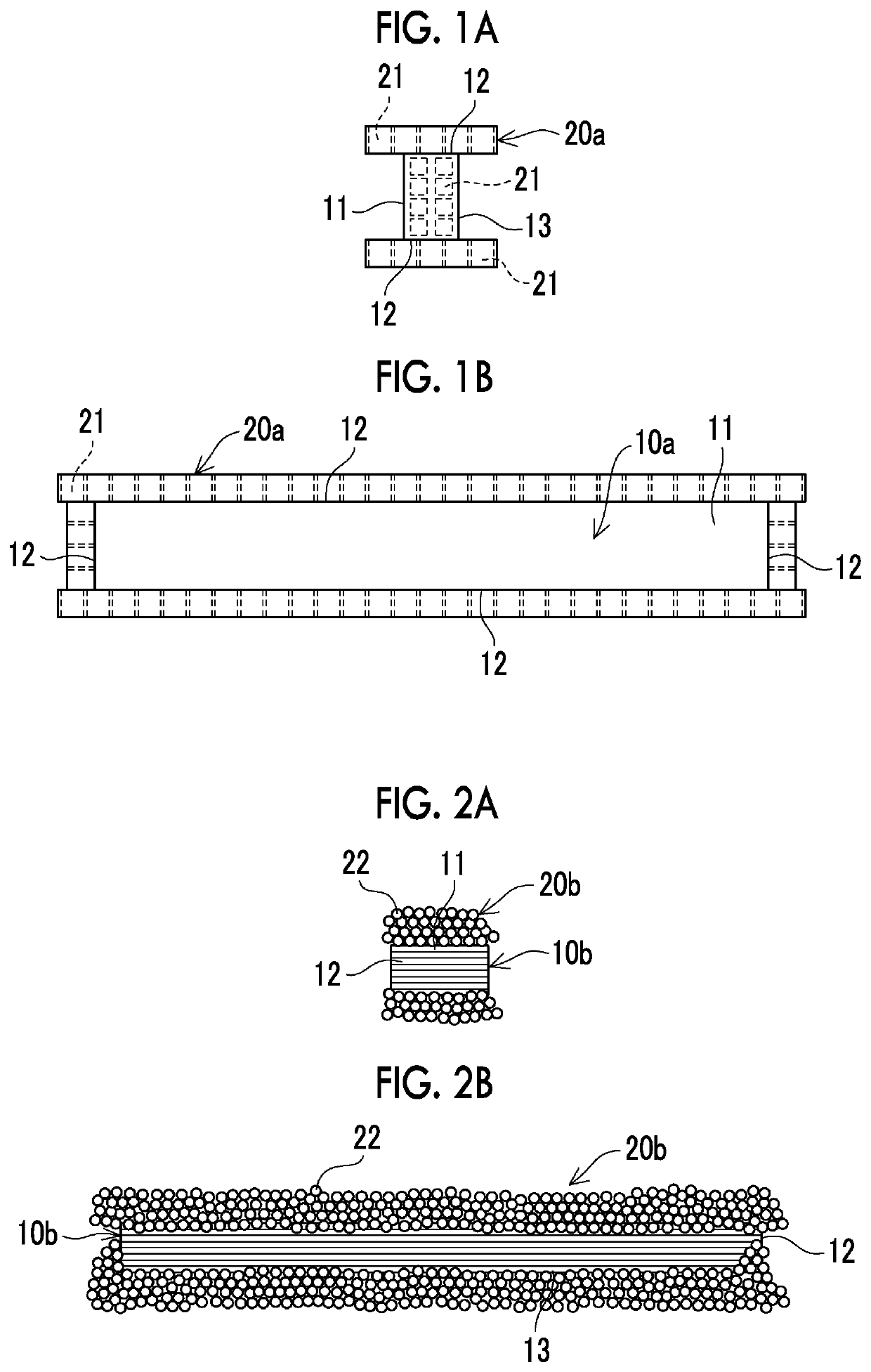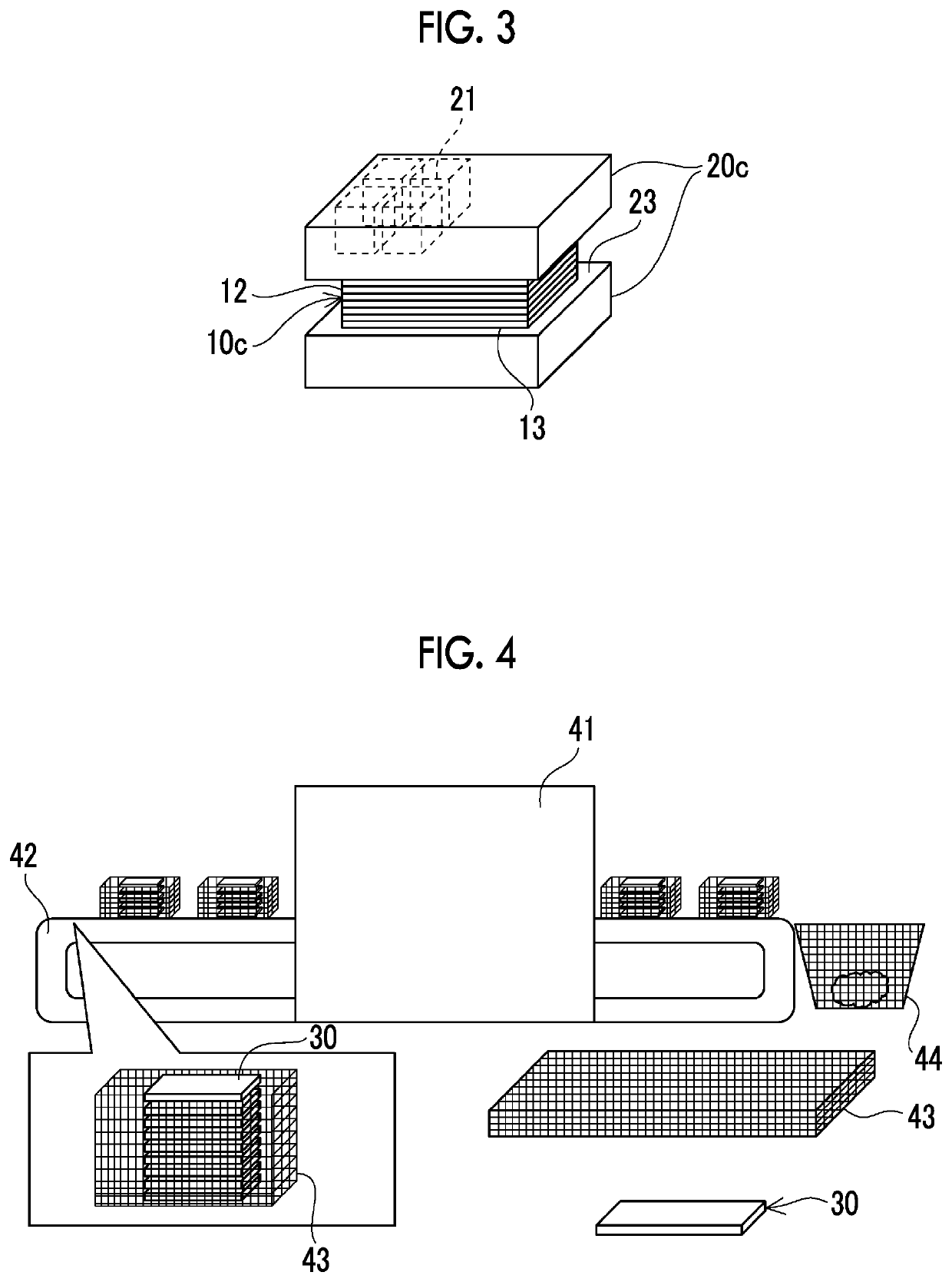Method for decomposing plastic composite
a plastic composite and decomposing technology, applied in the field of decomposing plastic composites, can solve the problems of difficult recycling of plastic composite waste materials, thermosetting resin and reinforcing fibers cannot be easily separated once cured, etc., and achieve the effect of efficient processing
- Summary
- Abstract
- Description
- Claims
- Application Information
AI Technical Summary
Benefits of technology
Problems solved by technology
Method used
Image
Examples
example 1
Catalyst
[0041]Tests were performed to decompose the plastic composite using various catalysts. As the plastic composite, a carbon fiber reinforced resin having a size of width 30 mm×length 200 mm×height 12 mm and epoxy resin as the matrix resin was used. As the catalyst, no catalyst used in Test Example 1, and a honeycomb type denitration catalyst (a ternary catalyst of TiO2 / V2O5 / WO3 or MoO3) with a cell size of 6.4 mm×6.4 mm×10 mm) was used in Test Example 2. In Test Example 3, a TiO2 granular catalyst (CS-200S-24 manufactured by SAKAI CHEMICAL CO., LTD., diameter: 2 to 4 mm) was used as it was. In Test Example 4, CuO (special grade reagent manufactured by KANTO CHEMICAL CO., INC.) was pressure-formed, crushed, rectified into granular shapes having a diameter of 2 to 4 mm, and then used.
[0042]In a case where the honeycomb type denitration catalyst was used, as illustrated in FIGS. 1A and 1B, all the four side surfaces, which are the layered surfaces of the plastic composite, were d...
example 2
hip Between Band Gap and Performance of Catalyst at Setting Temperature of 400° C.
[0049]5 g of respective granular catalysts (diameter of 2 to 4 mm) having Cr2O3, CuO, amorphous α-Al2O3 (alpha type alumina), V2O5, and TiO2 (anatase type) having different band gaps were placed on the front surface of 2 g of the plastic composite that is the same material as in Example 1, and tests were performed in the atmosphere with the setting temperatures of 400° C. and the holding time of 1.5 hours. Additionally, as a comparative example, a test was performed under the same conditions even in a case where the catalyst was not placed. The results are shown in FIG. 9. In addition, the vertical axis of the graph in FIG. 9 was not the weight decrease rate (%), but a weight decrease rate ratio (unit: none) that is the ratio of weight decrease rates of the respective catalysts in a case where the weight decrease rate in a comparative example without a catalyst was set to 1.
[0050]As illustrated in FIG....
example 3
ce of Denitration Catalyst at Setting Temperature of 400° C.
[0051]Regarding the honeycomb type denitration catalyst of Test Example 2 of Example 1 that is a TiO2-based catalyst, a test was performed under the same conditions as in Example 1 except that the setting temperature of the reactor was set to 400° C., gas (O2: 21 vol %, H2O: 1.38 vol %, N2: the balance) was caused to flow at a flow rate of 1 NL / min, the holding time was set to 4.5 hours, and the weight of the plastic composite during the test was continuously measured. In addition, as a comparative example, a test was performed under the same conditions even in a case where no catalyst was placed. The results are shown in FIG. 10. In addition, the right vertical axis of the graph of FIG. 10 represents a weight change ratio (unit: none) that is the ratio of a change in the weight of the plastic composite after the temperature rising time of 200 minutes with respect to the weight of the plastic composite before the test in th...
PUM
| Property | Measurement | Unit |
|---|---|---|
| band gap | aaaaa | aaaaa |
| atmospheric temperature | aaaaa | aaaaa |
| surface temperature | aaaaa | aaaaa |
Abstract
Description
Claims
Application Information
 Login to View More
Login to View More - R&D
- Intellectual Property
- Life Sciences
- Materials
- Tech Scout
- Unparalleled Data Quality
- Higher Quality Content
- 60% Fewer Hallucinations
Browse by: Latest US Patents, China's latest patents, Technical Efficacy Thesaurus, Application Domain, Technology Topic, Popular Technical Reports.
© 2025 PatSnap. All rights reserved.Legal|Privacy policy|Modern Slavery Act Transparency Statement|Sitemap|About US| Contact US: help@patsnap.com



